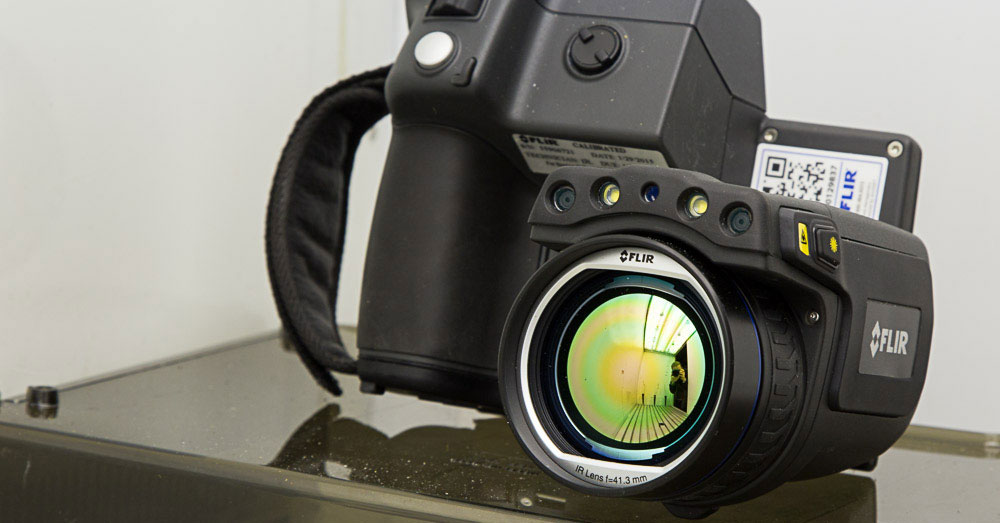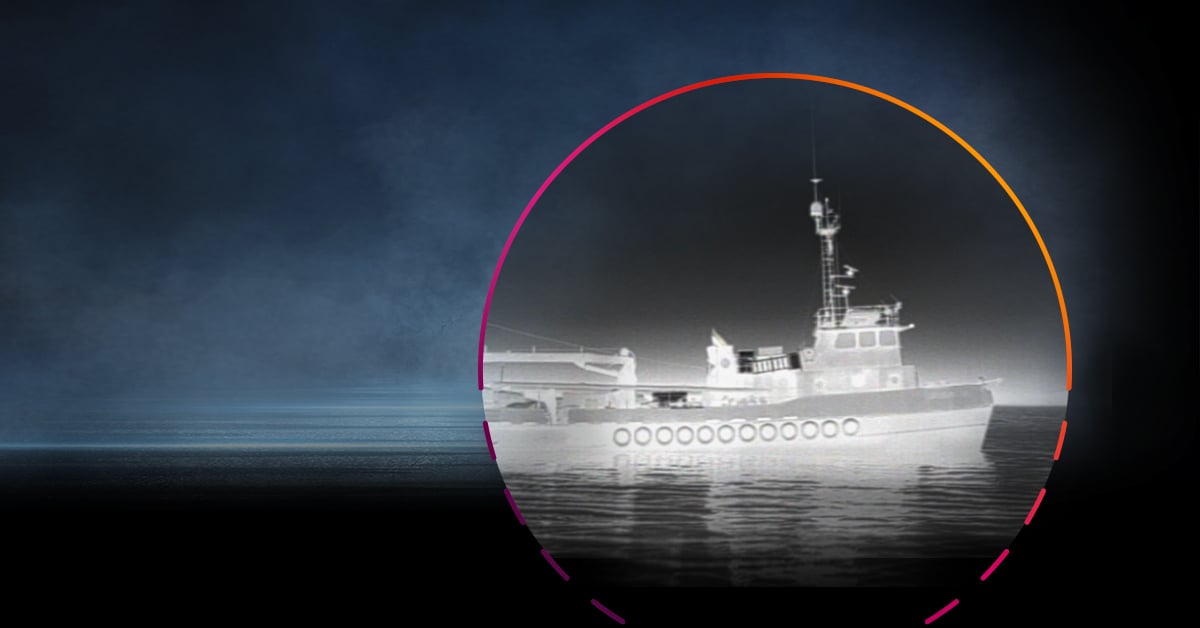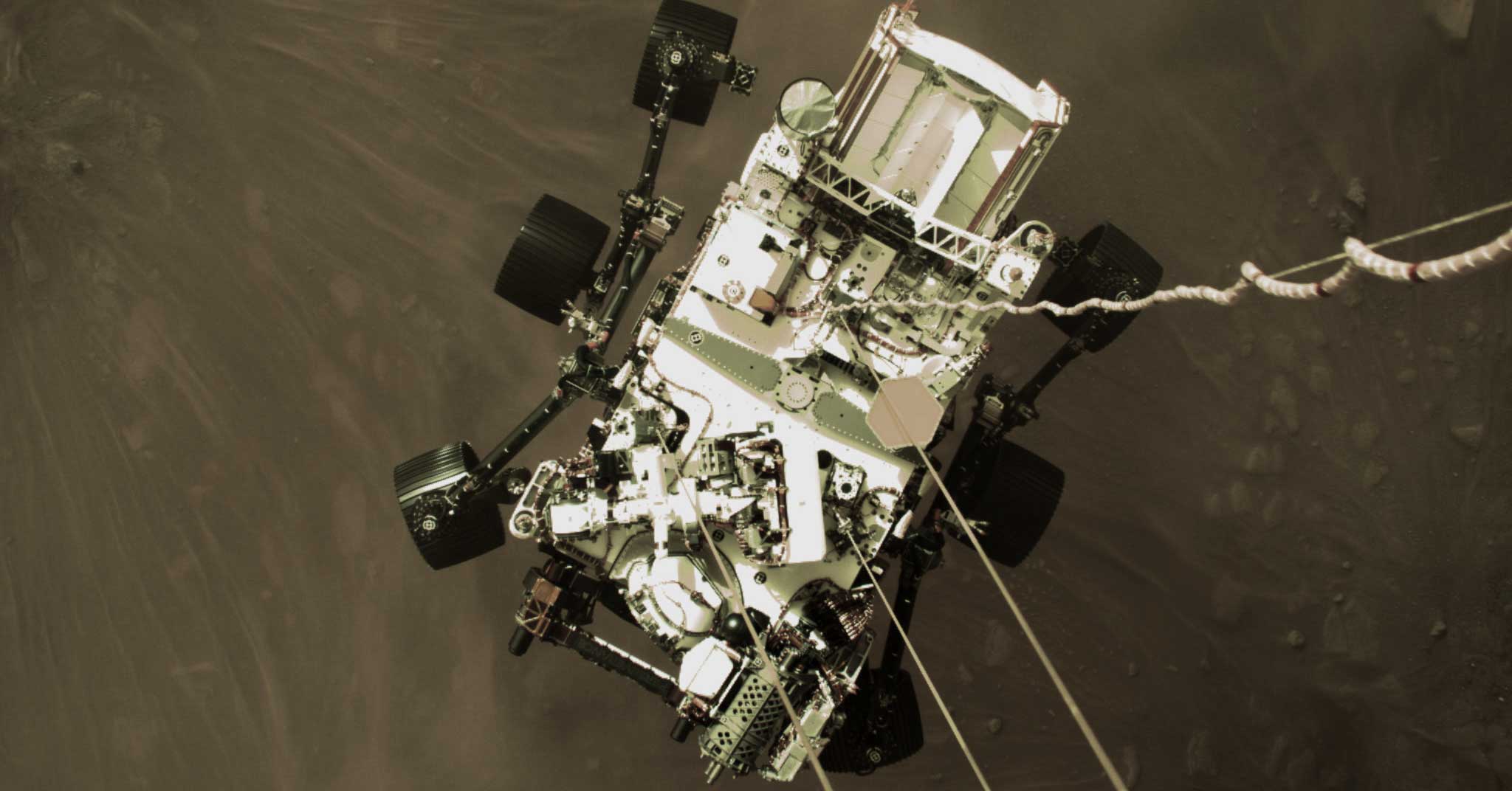Use Low-Cost Materials to Increase Target Emissivity
Clean, unoxidized, bare metal surfaces have quite low emissivity. So low, that they are difficult to measure with a thermal imaging camera. In many industrial R&D applications, there are many low-emissivity targets, especially for electrical applications. To get good measurements, we need to increase the emissivity of these problematic targets.
A thermal imaging camera records the intensity of radiation in the infrared part of the electromagnetic spectrum and converts it to a visible image. Infrared energy coming from an object is focused by the optics of the camera onto an infrared detector. The detector sends the information to sensor electronics for image processing. The electronics translate the data coming from the detector into an image that can be viewed in the viewfinder or on a standard video monitor or LCD screen. Infrared thermography is the art of transforming an infrared image into a radiometric one, which allows temperature values to be read from the image. So every pixel in the radiometric image is in fact a temperature measurement.
In order to interpret thermal images correctly, you need to know how different materials and circumstances influence the temperature readings from the thermal imaging camera. Emissivity is the efficiency with which an object emits infrared radiation, compared to a perfect emitter (or a so-called blackbody, which has an emissivity value of 1). In reality, targets we are likely to measure are not perfect radiators, with an emissivity value below 1. For these targets, the measured temperature will result from a combination of emitted, transmitted and reflected radiation. It is important to set the right emissivity value in your thermal imaging camera or the temperature measurements will be incorrect. FLIR Systems thermal imaging cameras have predefined emissivity settings for lots of materials, and the rest can be found in an emissivity table.
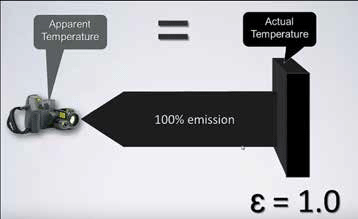
A perfect blackbody has an emissivity of 1. In other words, the radiation of the target is 100% emitted from the target surface.
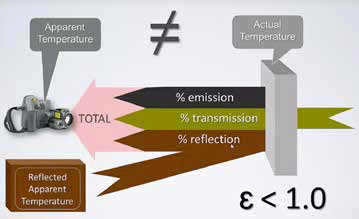
In reality, our targets are not perfect blackbodies. A target’s measured temperature will result from a combination of emitted, transmitted and reflected radiation.
A target’s emissivity, reflectance and thermal conductivity values will be highly dependent on material properties. Most non-metals have emissivity values near 0.9, which means that 90% of the measured radiation comes from radiation emitted by the target. Most polished metals have emissivity values near 0.05 to 0.1. Tarnished, oxidized or otherwise corroded metals have emissivity values ranging from 0.3 to 0.9 depending on the amount of oxidation or corrosion. Materials with emissivity below 0.7 are difficult to measure, materials with emissivity below 0.2 are almost impossible to measure, without increasing the emissivity value in some way or another. Fortunately, there are cost-effective ways to compensate for low-emissivity on targets. These methods reduce the reflectance of the target and thus improve the measurement accuracy.
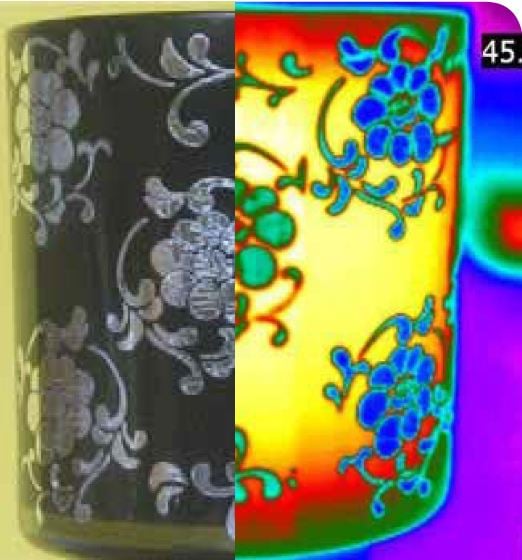
If you look at the thermal image you might think that the leaves are colder than the mug surface. In reality they have exactly the same temperature, the difference in intensity of infrared radiation is caused by a difference in emissivity.
Electrical Tape
Most high-quality electrical tape has an emissivity of 0.95. One must be careful, especially with mid wavelength cameras (3-5 μm), that the tape is opaque. Some vinyl tapes are thin enough to have some infrared transmittance, and are therefore unacceptable for use as high-emissivity coatings. Scotch™ Brand 88 black vinyl electrical tape has an emissivity of 0.96 in both the short wavelength (3-5 μm) and long wavelength (8-12 μm) regions, and is recommended.
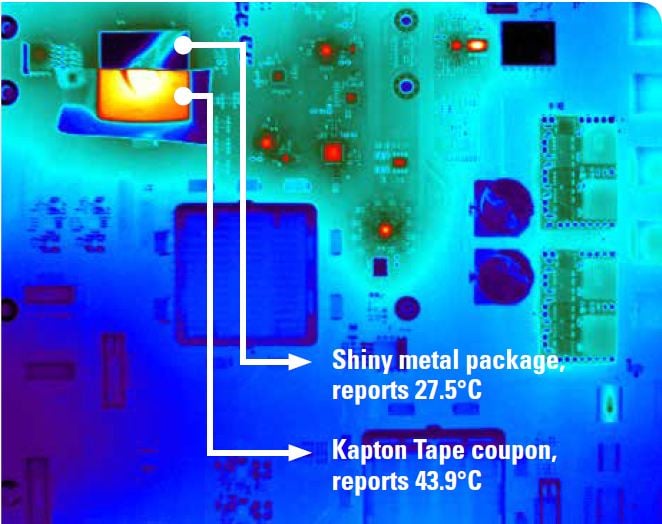
Temperature of a large ASIC with a shiny metal cap: without any coating, the ASIC reported near room temperature. Once a layer of high emissivity Kapton tape was applied, the true temperature of 43.9°C was reported.
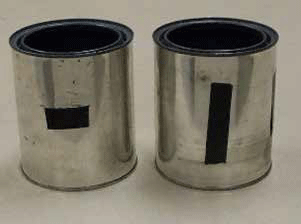
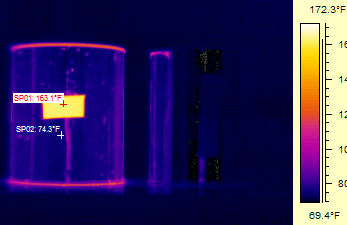
This example shows two cans with tape. The one on the left is filled with hot water; the other is at ambient temperature. For the hot can, the temperature ead from the tape is 163 °F (72.8 °C), from the can is 74.3 °F (23.5 °C). The latter reading is essentially ambient temperature as the emissivity of the can is quite low. This is a classic example of the necessity of using a high-emissivity application on a low-emissivity target.
Paints & Coatings
Most paints have an emissivity of about 0.9 to 0.95. Metallic based paints have low emissivity and are not recommended. The color of the paint is not the significant variable in its infrared emissivity. The flatness of the paint is more important than its color. Flat paints are preferred over glossy paints. The coating must also be thick enough to be opaque. Two coats usually suffice. Tape is good for small areas. Paint is good for larger areas, but this is a permanent coating. For coatings over large areas that need to be removed, or where tape is inappropriate, powders suspended in slurry or spray form can work well. Dye penetrant developer and Dr. Scholl’s™ spray foot powder are two examples. Emissivities of these powders are in the 0.9 to 0.95 range, providing they are applied thick enough to be opaque.
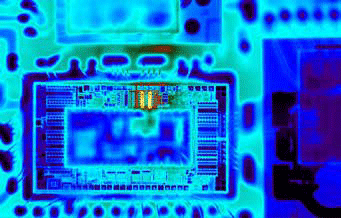
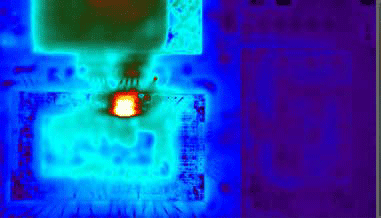
Left: PCB without emissivity-increasing paint. Right: with emissivity-increasing paint. The downside of using paints can be the reduction of fine details.
White Out Correction Fluid
Applying white-out is a great way to raise the emissivity of a surface. This method can be applied to the smallest electrical components, as opposed to the tape which will not stick to small surfaces. The white-out washes off by using a small brush and alcohol. Emissivity of white-out is about 0.95 - 96 for a LW camera.
Further Recommendations
As many of these targets are often electrically energized, it is always required to be careful. This means coating the targets only when they are not energized and only using an approved coating to ensure proper operation when energized. Be sure you make the coating cover an area of sufficient size. Know your camera’s spot size ratio for measurement, and the minimum operating distance you can safely employ. For example, a camera with a 250:1 spot size ratio can measure a one-inch target at a maximum of 250 inches, or 20.8 feet (or a one-centimeter target at a maximum of 250 centimeters – or 2.5 meters). For higher temperature applications, use high-temperature paint such as engine or charcoal grill paint. Tapes and powders are limited in temperature range of application. For electrical systems, if the tape is melting, the problem is probably significant. So, you should not need a high-temperature material for this application.
Controlling Emissivity Values on PCB Boards
During fault-finding procedures, measuring the temperatures of components on a populated Printed Circuit Boards (PCB) can be a very helpful and cost-effective technique, but is difficult due to the different e-values of the different components. Usually, PCBs are populated with a variety of metal and plastic components manufactured by different manufacturers who apply their own finishes to the components. When the board gets treated with a known, tested and characterized coating, it normally simplifies the problem. After coating, the component surfaces have the same e-values and the relative temperatures can be determined by taking a thermogram.
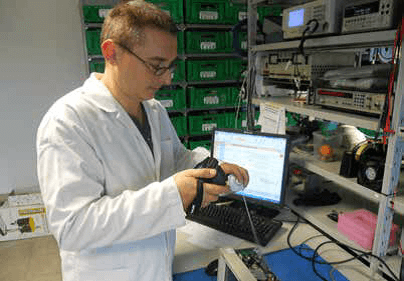
To control emissivity values, you can treat a PCB board with a coating.
Determinging Emissivity
Knowing the emissivity value is necessary for true temperature evaluation from the measure radiation. However, table values of emissivity must be used with caution. Often it is not clear over what wavelength band the emissivity value is valid. And emissivities do change with wavelength. Also surface condition, texture and shape play key roles in the emissivity of a material. Here is one way to understand the effect of emissivity uncertainty on measurement accuracy: Suppose the uncertainty in target emissivity is ±0.05. For an emissivity of 0.95, this represents about a 5% error (0.05/0.95). For a material such as shiny copper, emissivity 0.05, this represents a 100% error (0.05/0.05). These errors propagate into the temperature calculation, increasing the error in temperature reading. Our recommendation is to not attempt temperature measurement for target emissivities below about 0.5 because of this effect. Coat the target with a high-emissivity material.
|
Temporary |
Permanent |
| Dye penetrant developer | Liquid Tape 1/16” |
| Stick-on paper dots | Plasti-dip 1/32” |
| White out (long wave) | Flat non-metallic paint |
| Masking tape | Scotch 70 silicone rubber |
| Scotch 33 black vinyl electrical tape | Bulldog #8 rubber (self-adheres) |
| Candle soot (small targets) | W.H. Brady Labels (stick-on) |
| Contact paper | Friction tape (self-adheres) |
|
Kapton tape (polyimide film with silicone adhesive) |
Porcelain touchup enamel |
| PCB lacquer plastic 70 (RE) |
High emissivity coating materials
